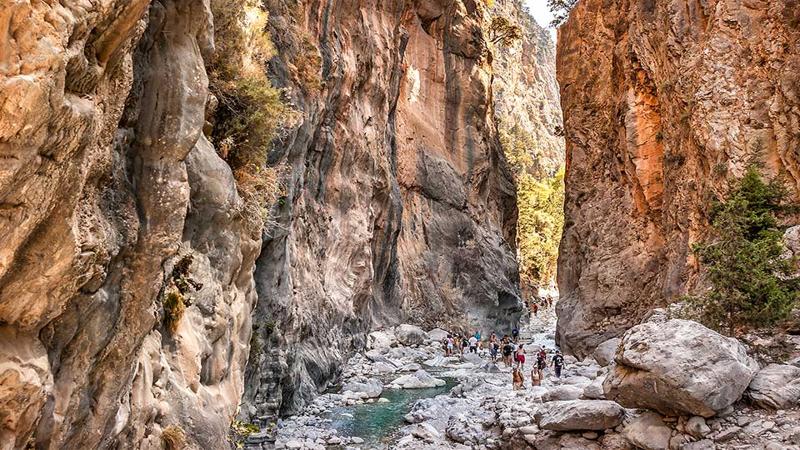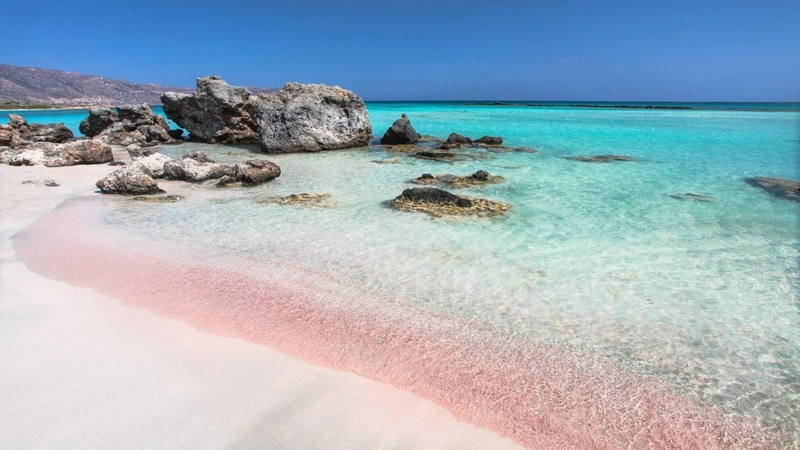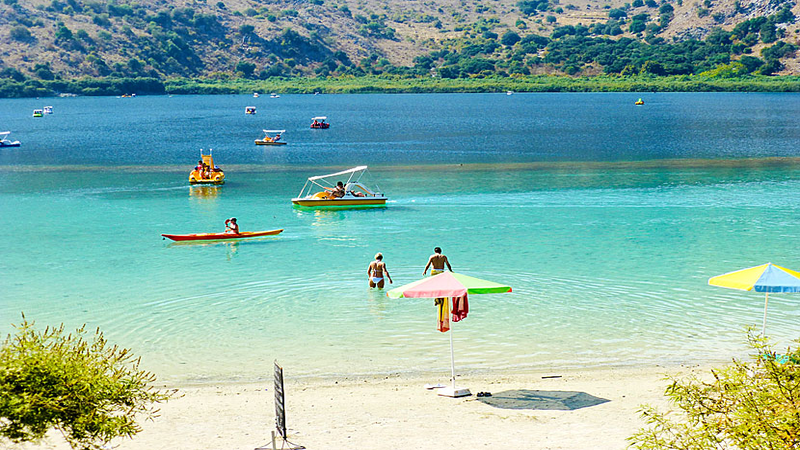Kourtaliotiko Gorge Crete: Hidden Waterfalls & Pools Paradise
Discover everything you need to know about this spectacular gorge with pristine waterfalls, secret swimming holes, and dramatic landscapes away from the tourist crowds
Kourtaliotiko Gorge: Crete's Best-Kept Secret Waterfall Paradise
Located in southern Crete between Rethymno and Plakias, Kourtaliotiko Gorge (also called Kotsifou Gorge) is one of the island's most spectacular yet underappreciated natural wonders. Unlike the famous but crowded Samaria Gorge, Kourtaliotiko offers a more intimate and accessible experience featuring dramatic rock walls, hidden waterfalls, pristine swimming holes, and lush vegetation—all without requiring a strenuous all-day hike. This comprehensive guide covers everything you need to know about visiting this magical place—from detailed directions and trail options to the best swimming spots, waterfall locations, and essential preparations to make your visit unforgettable.
Contents
About Kourtaliotiko Gorge
Kourtaliotiko Gorge is a natural masterpiece carved by the Kourtaliotis River through the imposing limestone mountains of southern Crete. The gorge extends for about 3 kilometers with dramatic rock walls rising up to 600 meters high in some sections, creating one of the most impressive landscapes on the island.
What makes Kourtaliotiko truly special is the combination of flowing water, lush vegetation, and dramatic geology—elements that are relatively rare on often-arid Crete. The gorge is named after the unique sounds ("kourtala") created by the wind as it whistles through the narrow passages between the high cliffs.
Unlike some of Crete's other gorges that require long, challenging hikes, Kourtaliotiko offers multiple experiences for different adventure levels. Visitors can enjoy spectacular views from the road that passes through part of the gorge, take short walks to accessible viewpoints, or venture deeper into the canyon for more adventurous exploration of hidden waterfalls and swimming holes.

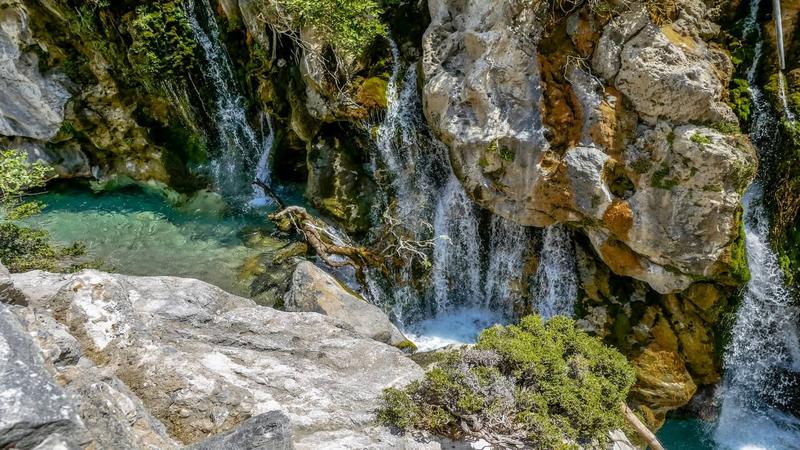
The Kourtaliotiko River
The lifeblood of the gorge is the Kourtaliotis River, which flows year-round (unusual for Crete) and creates the series of waterfalls and pools that make this place so special. Fed by underground springs, the water maintains a refreshingly cool temperature even in the hottest summer months, typically around 12-14°C (54-57°F).
The river eventually emerges from the gorge and flows into the Libyan Sea near Preveli Beach, another famous attraction in southern Crete with its palm forest. This continuous water flow has created a rich ecosystem within the gorge, supporting lush vegetation that forms a striking contrast to the stark limestone cliffs.
Cultural and Religious Significance
Kourtaliotiko Gorge has historical and religious significance for locals. The small white church of Agios Nikolaos sits near the entrance of the gorge, and five historic chapels are built into the rock walls further inside. These chapels were places of refuge during Ottoman occupation and remain sites of pilgrimage today.
According to local legend, the sound of "kourtala" (clapping) heard in the gorge comes from the hands of saints protecting the area. Others attribute the unique acoustics to the particular rock formations and wind patterns. Regardless of the explanation, the mysterious sounds add to the magical atmosphere of the gorge.
How to Get to Kourtaliotiko Gorge
Distance from Chania: 80 km (approximately 1 hour 20 minutes drive)
Distance from Heraklion: 100 km (approximately 1 hour 45 minutes drive)
Road Condition: Excellent paved roads all the way to gorge entrance
GPS Coordinates: 35.1887° N, 24.4739° E (main parking area)
By Car (Only Practical Option)
Kourtaliotiko Gorge is only accessible by car, as there is no public transportation that serves this area. The scenic drive itself is part of the experience, with stunning mountain views along the way:
From Rethymno:
- Take the main road (E75) south from Rethymno toward Spili
- Follow signs to Spili and then continue toward Plakias/Preveli
- After passing through Spili, continue south for about 10 km
- You'll begin to see the dramatic gorge opening and will drive directly through part of it
- The main parking area and trailhead is on the right side, with a small church (Agios Nikolaos) and a natural spring
From Chania:
- Take the main highway (E75) east toward Rethymno
- Follow the Rethymno directions above once you reach the city
- Alternatively, for a more scenic route, you can drive along the south coast via Hora Sfakion and Frangokastello
Parking Information
There are several parking options around the entrance to Kourtaliotiko Gorge:
- Main Parking Area: Located next to the church of Agios Nikolaos, this small paved area can accommodate about 15-20 cars. It's free and the most convenient starting point for exploring the gorge.
- Roadside Parking: If the main parking area is full, there are several wider sections along the road where parking is possible. Ensure your vehicle doesn't block traffic.
- Secondary Parking: A smaller parking area located about 500 meters into the gorge, suitable for visiting the upper waterfall only.
The parking situation is relatively easy compared to more popular tourist sites in Crete, but arriving earlier (before 11:00 AM) is recommended during peak summer months to secure a spot in the main area.
Best Time to Visit
Best Time of Day: Morning (8:00-11:00 AM) for optimal lighting and fewer people
Water Flow: Strongest in spring after winter rains (April-May)
Water Temperature: Consistently cold (12-14°C/54-57°F) year-round
Avoid: Midday heat in July-August and rainy periods with risk of flash floods
Seasonal Considerations
Kourtaliotiko Gorge offers different experiences throughout the year:
- Spring (April-June): Ideal time with moderate temperatures, strongest water flow, and abundant wildflowers. The waterfalls are at their most impressive, and swimming, while cold, is refreshing rather than freezing.
- Summer (July-August): Very hot in the middle of the day, but the gorge provides natural shade and cool water. Early morning visits are recommended to avoid high temperatures. Water levels are lower but still flowing.
- Early Autumn (September-October): Excellent conditions with pleasant temperatures and fewer visitors. Water flow is reduced compared to spring but still sufficient for beautiful waterfalls.
- Winter (November-March): Visits are possible but not recommended during rainy periods due to potential flash flood danger. On clear winter days, the gorge offers peaceful solitude, but swimming would be extremely cold.
Time of Day Considerations
The time of day significantly affects your experience at Kourtaliotiko:
- Early Morning (8:00-11:00 AM): Optimal time with beautiful light filtering into the gorge, cooler temperatures, and fewer visitors. Photography is best during these hours as sunlight reaches the waterfalls.
- Midday (11:00 AM-3:00 PM): Most crowded time and hottest temperatures, especially in summer. The high sun creates harsh contrasts for photography but does create beautiful light beams in some sections of the gorge.
- Late Afternoon (3:00-6:00 PM): Crowds begin to diminish, and temperatures become more comfortable. However, much of the gorge falls into shadow, making photography more challenging.
For the ideal experience, aim to arrive at the gorge early in the morning, especially during summer months. This allows you to enjoy the waterfalls with optimal lighting and comfortable temperatures, with the option to continue to nearby attractions like Preveli Beach in the afternoon.
Trail Options & Paths
Kourtaliotiko Gorge offers several trail options varying in difficulty and destination. Unlike some Cretan gorges with a single defined path, Kourtaliotiko presents choices that allow visitors to tailor their experience based on time, fitness level, and adventure preferences:
Starting from the main parking area near the church, take the left path that follows alongside the river. This relatively easy trail leads to a series of peaceful river pools where the Kourtaliotis River flows gently through the gorge. The path involves some rock hopping and navigating around boulders but is manageable for most people including families with older children.
This route takes you to crystal-clear pools perfect for a refreshing dip in hot weather, with small cascades connecting them. The pools vary in depth from ankle-deep to chest-deep in some sections. Many visitors spend time here relaxing by the water and enjoying the tranquil atmosphere within the gorge walls.
From the main parking area, the right path leads to the more adventurous section of the gorge featuring a series of waterfalls and ultimately the hidden cave. This trail requires some scrambling over rocks, navigating through shallow water sections, and careful footing on sometimes slippery surfaces.
The path follows the river upstream through increasingly narrow sections of the gorge, passing several impressive waterfalls of varying heights. Each waterfall has its own pool at the base, with depths suitable for swimming. The trail becomes more challenging as you progress, requiring basic climbing skills in some sections.
This less-traveled trail begins about 300 meters from the main parking area, branching uphill to the left. It climbs along the eastern wall of the gorge via a series of switchbacks, offering increasingly panoramic views of the gorge and surrounding landscape.
While not leading to water features, this path rewards hikers with spectacular photographic opportunities looking down into the gorge from above. The trail is steep in sections but has some areas with stone steps and occasional ropes attached to trees for assistance.
This easy walking route follows the paved road through the gorge with detours to visit the five historic chapels built into the rock walls. Starting from the main church of Agios Nikolaos, the path follows the road for approximately 1.5km, with clear signs indicating the location of each chapel.
This is the easiest option for those with limited mobility or families with small children, offering impressive views of the gorge walls without challenging terrain. The chapels themselves provide fascinating glimpses into local religious traditions and history.
The Waterfalls & Swimming Holes
The highlight of Kourtaliotiko Gorge is its series of waterfalls and pristine swimming holes. Fed by year-round underground springs, these water features remain impressive even during Crete's dry summer months, offering spectacular natural beauty and refreshing swimming opportunities:
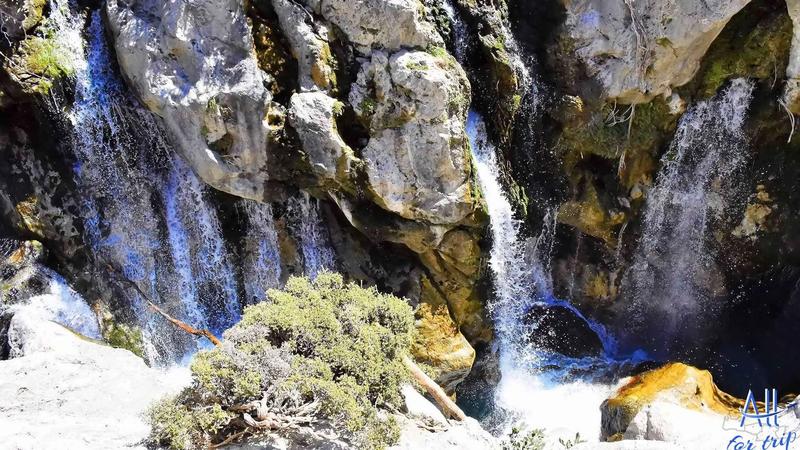
The first major waterfall encountered on the right path features a modest 3-meter cascade into a stunning emerald pool approximately 15 meters in diameter. The pool is deep enough for swimming (around 2 meters at its center) and surrounded by smooth rocks perfect for sitting and sunbathing.
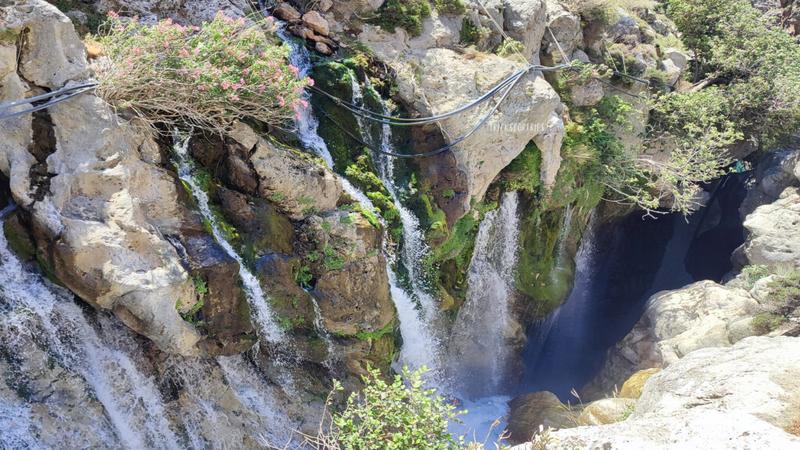
The most impressive waterfall in the gorge drops approximately 10 meters from a dramatic rock overhang into a deep, circular pool. The water volume is strongest in spring but remains significant year-round. Sunlight filtering through the gorge creates rainbow effects in the mist during morning hours.

Beyond the main waterfall, a series of smaller cascades creates a natural staircase effect. These interconnected falls range from 1-4 meters in height and form numerous small pools between them. The surrounding area becomes increasingly narrow and canyon-like, with dramatic rock walls.
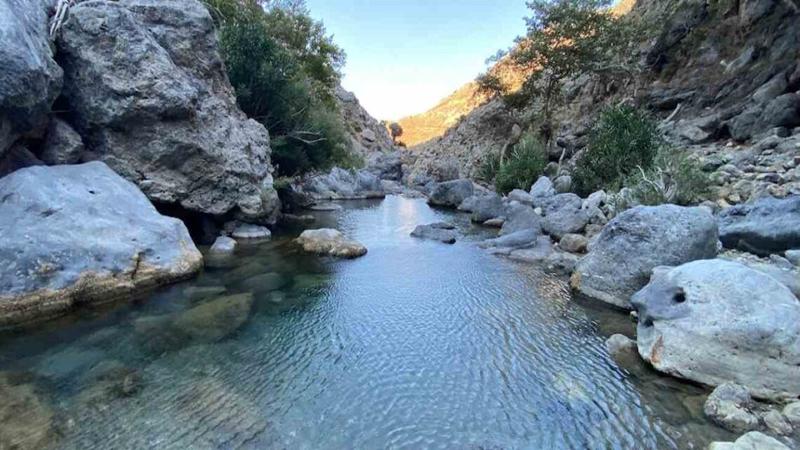
The left path features a different water experience with a series of tranquil, interconnected river pools. While lacking the dramatic drops of the waterfalls, these crystal-clear pools offer easier access for swimming and wading, with beautiful emerald colors against white rocks.
Swimming Considerations
Swimming in Kourtaliotiko's pools and waterfalls is a highlight for many visitors, but there are important considerations:
- Water Temperature: The water remains cold year-round (12-14°C/54-57°F) due to its spring source. Even in summer, extended swimming may cause numbness in extremities.
- Current Strength: Water flow varies seasonally. Spring months (April-May) see stronger currents that can make swimming challenging in some areas, particularly near waterfalls.
- Entry and Exit Points: Most pools have limited entry/exit points due to surrounding rocks. Scout these before swimming.
- Underwater Hazards: Some pools have submerged rocks or logs. Use caution, especially when diving or jumping.
- No Lifeguards: There is no supervision or emergency services nearby. Swim according to your abilities and never alone.
The Secret Cave
Beyond the series of waterfalls on the right path lies one of Kourtaliotiko's most extraordinary features—a hidden cave accessible only by swimming through a short underwater passage. This adventure is not for everyone but offers a truly unique experience for those willing to undertake it:
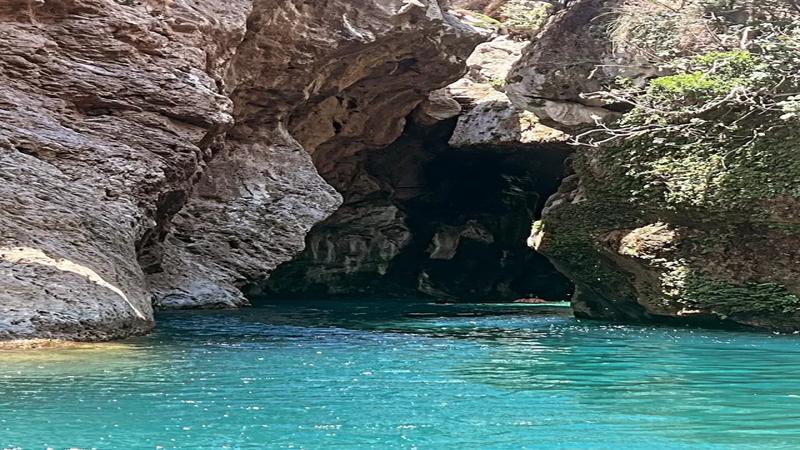
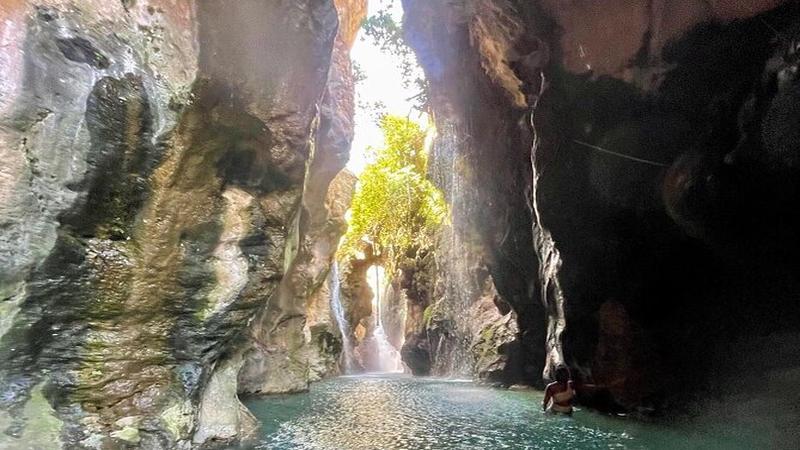
Cave Access & Details
- Location: The cave entrance is located just beyond the upper falls, approximately 30-40 minutes from the main parking area.
- Access Method: Reaching the cave requires swimming through a water-filled passage approximately 2-3 meters long.
- Water Temperature: Very cold (8-10°C/46-50°F), colder than the external pools.
- Difficulty Level: High - only for confident swimmers comfortable with brief underwater swimming.
- Cave Interior: A cathedral-like chamber approximately 15 meters in diameter with a high ceiling adorned with stalactites.
- Natural Light: Filtered light enters through small openings in the ceiling, creating ethereal light beams.
The Cave Experience
For those who make it through the underwater passage, the cave interior offers a breathtaking reward. Upon surfacing inside the cave, you'll find yourself in a remarkable natural cathedral. The domed ceiling rises several meters above the water surface and is adorned with delicate stalactites formed over thousands of years.
What makes this cave particularly magical is the way light enters through small fissures in the ceiling. These natural skylights create dramatic light beams that pierce the darkness, especially during midday hours when the sun is directly overhead. The water inside the cave has an ethereal blue glow from this filtered light.
The cave includes a small rocky ledge where a few people can sit to rest and take in the surroundings. The acoustics inside the chamber create interesting echo effects, adding to the otherworldly atmosphere.
Cave Preparation Tips
If you're considering visiting the cave, these preparations will help:
- A waterproof headlamp or flashlight is useful for examining cave details
- Consider wearing a rash guard or thin wetsuit top if you're sensitive to cold
- Remove any bulky items or accessories before attempting the swim
- Waterproof cameras or phone cases allow you to capture the unique interior
- Visit with a partner who can assist if needed
The cave remains one of Crete's best-kept secrets, known primarily to locals and adventurous visitors. Its challenging access has helped preserve its pristine condition and the sense of discovery that comes with reaching it.
Difficulty & Accessibility
Kourtaliotiko Gorge offers experiences across a range of difficulty levels, allowing visitors to choose adventures appropriate for their abilities. Understanding these different challenges helps you plan accordingly:
Physical Demands
The various paths in Kourtaliotiko Gorge involve different physical challenges:
- Walking & Hiking: Distances range from 500m to 1.5km one-way on uneven terrain
- Rock Scrambling: The waterfall route requires using hands for balance and occasionally climbing over obstacles
- Water Crossings: Several paths involve wading through ankle to knee-deep water
- Boulder Hopping: Navigating between and over rocks of various sizes
- Cold Water Exposure: Swimming in cold water (12-14°C/54-57°F)
- Heat Exposure: Limited shade in some sections, particularly during midday hours
Accessibility for Different Groups
Here's guidance for different visitors:
Families with Children:
- The left path (River Pools) is suitable for families with children 8 and older who are comfortable with some uneven terrain
- The roadside chapels path is appropriate for all ages
- The right path beyond the first waterfall is not recommended for children under 12
- The cave should only be attempted by strong teenage swimmers accompanied by adults
Older Adults and Seniors:
- Active older adults can enjoy most areas with reasonable caution
- The roadside chapels offer an excellent experience with minimal physical demands
- Walking poles are helpful for stability on uneven terrain
- Consider visiting in cooler morning hours to avoid heat stress
Visitors with Mobility Limitations:
- The gorge trails are not wheelchair accessible
- Those with mild mobility limitations can enjoy views from the road and potentially the beginning of the left path
- Some impressive views are visible directly from the parking area and roadside stops
Essential Preparation
Proper preparation ensures a safe and enjoyable visit to Kourtaliotiko Gorge. With limited facilities and sometimes challenging conditions, coming prepared is essential:
Kourtaliotiko Gorge Packing Essentials
- Proper footwear: water shoes or hiking sandals with good grip
- At least 1.5 liters of water per person
- Sun protection (hat, sunscreen, sunglasses)
- Towel and change of clothes
- Small first-aid kit (bandages, antiseptic)
- Swimwear (if planning to swim)
- Light snacks or picnic
- Waterproof bag or case for valuables
- Camera (preferably waterproof)
- Small daypack to carry supplies
- Walking poles if you use them
- Thin wetsuit top or rash guard (for cave exploration)
- Waterproof headlamp (for cave exploration)
- Insect repellent (particularly in summer)
* Items marked with asterisk are absolutely essential
Footwear Considerations
Proper footwear is perhaps the most critical preparation for Kourtaliotiko Gorge:
- Best Option: Closed-toe water shoes or hiking sandals with good traction
- Avoid: Flip-flops, regular sandals, or street shoes
- Why It Matters: You'll be walking on wet, slippery rocks, potentially wading through water, and navigating uneven terrain
- Alternative: Hiking boots for dry sections, with separate water shoes if planning to swim
Water & Food
There are no facilities for purchasing food or water in the gorge:
- Bring at least 1.5 liters of water per person, more in hot weather
- Pack energy-rich snacks like nuts, dried fruit, or energy bars
- A small picnic can be enjoyed at several pleasant spots along the river
- Remember to pack out all your trash
Sun Protection
While parts of the gorge offer shade, others are fully exposed:
- Apply waterproof sunscreen before entering the gorge
- Wear a hat with a brim for face and neck protection
- Consider UV-protective clothing, especially for children
- Sunglasses protect against glare off water and rock surfaces
Photo Spots & Photography Tips
Kourtaliotiko Gorge offers exceptional photography opportunities, from dramatic landscapes to intimate water details. Here are the best spots and techniques for capturing this natural wonder:
Top Photo Locations
- Main Road Viewpoints: Several pullouts along the main road offer dramatic views of the towering gorge walls that provide context for the scale of the landscape.
- First Waterfall Pool: The emerald colors of this pool against white rocks create stunning contrasts, especially in morning light.
- Main Waterfall: The 10-meter cascade offers classic waterfall photography opportunities, with morning hours providing the best light.
- Upper Viewpoint: This elevated perspective gives a sweeping view of the gorge and river that's perfect for landscape composition.
- River Pools: The crystal-clear water with small cascades offers opportunities for both wide and detail shots.
- Cave Interior: For adventurous photographers, the light beams penetrating the cave create otherworldly images.
Best Times for Photography
Light conditions significantly impact gorge photography:
- Early Morning (8:00-10:00 AM): The low-angle light illuminates the gorge walls beautifully and creates softer contrasts. Water features show their colors most vividly in this light.
- Midday (11:00 AM-2:00 PM): Harsh for most landscape photography but ideal for capturing light beams in the cave and certain sections of the gorge where sun penetrates directly.
- Late Afternoon (3:00-5:00 PM): The western-facing sections receive warm golden light, though many areas fall into shadow.
Technical Considerations
- Equipment Protection: A waterproof camera or case is ideal. Alternatively, use a dry bag between shooting locations.
- Lenses: A wide-angle lens (16-35mm equivalent) captures the dramatic gorge walls, while a medium zoom (24-70mm equivalent) is perfect for waterfall details.
- Tripod: Useful for waterfall photography with slower shutter speeds, though can be cumbersome on the trails.
- Waterfall Technique: Use shutter speeds between 1/15 and 1/2 second to create silky water effects while maintaining detail.
- Underwater: Consider a simple underwater camera or waterproof phone case for capturing the emerald pools from water level.
Composition Ideas
- Use the towering gorge walls to frame water features
- Include people for scale to demonstrate the impressive dimensions
- Focus on the contrast between rough rock textures and smooth flowing water
- Capture reflections in the still pools
- Look for patterns in the rock formations and water flow
- Consider both landscape and portrait orientations for different perspectives
The ever-changing light conditions and water flows ensure that Kourtaliotiko Gorge offers fresh photographic opportunities throughout the day and across different seasons. Morning visits typically provide the most favorable overall conditions for photography.
Nearby Attractions
Kourtaliotiko Gorge's location in southern Crete places it near several other outstanding attractions. With your rental car, these destinations can be easily combined for a full day of exploration:
Preveli Palm Beach
One of Crete's most distinctive beaches where a palm forest meets the sea:
- Distance from Kourtaliotiko: 16 km (25-30 minutes drive)
- River flowing through a palm grove into the Libyan Sea
- Unique landscape combining beach, river, and palm trees
- Requires a moderate downhill hike (20 minutes) to access
- Basic facilities including some beach canteens in summer
Preveli Monastery
Historic monastery with rich cultural significance:
- Distance from Kourtaliotiko: 14 km (20 minutes drive)
- Founded in the Middle Ages with impressive architecture
- Played significant role in Cretan resistance during WWII
- Beautiful courtyard and church with notable iconography
- Small museum of religious artifacts
- Modest entrance fee (€2.50) and appropriate dress required
Spili Village
Charming traditional mountain village:
- Distance from Kourtaliotiko: 10 km (15 minutes drive)
- Famous for its Venetian fountain with 19 lion heads
- Traditional tavernas serving authentic Cretan cuisine
- Local shops selling handmade products and herbs
- Pleasant village square under plane trees
- Cooler temperatures thanks to its mountain elevation
Plakias Beach
Expansive sandy beach with excellent facilities:
- Distance from Kourtaliotiko: 12 km (20 minutes drive)
- Long, wide beach with golden sand and clear water
- Full range of facilities including restaurants and water sports
- Less crowded than major northern coast beaches
- Several smaller coves nearby for more secluded swimming
- Charming seaside village with accommodations and dining
Suggested South Crete Day Trip
Combine these attractions for a perfect day exploring the region:
- Morning (8:00-11:00 AM): Explore Kourtaliotiko Gorge when lighting is best and temperatures coolest
- Late Morning: Visit Spili Village for coffee and a light snack at the square
- Midday: Drive to Preveli Monastery for cultural exploration
- Afternoon: Hike down to Preveli Palm Beach for swimming and relaxation
- Evening: Enjoy dinner in Plakias with sunset views over the Libyan Sea
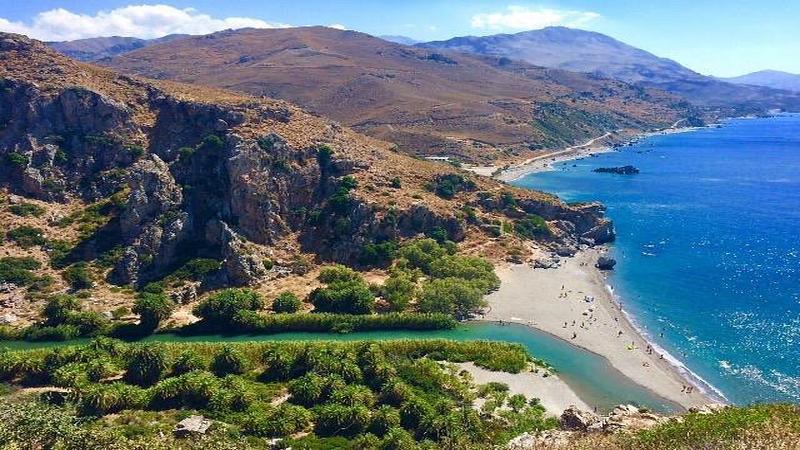
Preveli Palm Beach
Exotic landscape where a palm forest meets the Libyan Sea, creating one of Crete's most distinctive beaches.
Discover Preveli →
Spili Village
Charming mountain village with a famous Venetian fountain, traditional tavernas, and authentic Cretan atmosphere.
Discover Spili →
Plakias Beach
Expansive golden sand beach with excellent facilities, clear waters, and a relaxed atmosphere away from mass tourism.
Discover Plakias →Frequently Asked Questions About Kourtaliotiko Gorge
The time needed to properly experience Kourtaliotiko Gorge depends on which paths you choose to explore. For a basic visit covering just the left path (river pools) or right path (first waterfall), allow 1-2 hours including parking and preparation. To fully explore both the left and right paths, including the main waterfall, plan for 2-3 hours. For the complete experience including the upper falls and secret cave, set aside at least 3-4 hours. Many visitors combine their gorge visit with other nearby attractions like Preveli Palm Beach or Spili Village for a full day excursion. We recommend arriving in the morning (before 10:00 AM) when lighting is best, temperatures are cooler, and you have maximum flexibility with your time.
Parts of Kourtaliotiko Gorge are suitable for children, while others are not. The roadside chapels path and the left path (river pools) are appropriate for families with children aged 6 and older who are comfortable with some uneven terrain and supervision. These areas offer safe opportunities to experience the gorge's beauty and some wading in shallow water. The right path to the first waterfall can be manageable for active children 8 and older with close supervision. However, the sections beyond the main waterfall, including the upper falls and especially the secret cave, are not recommended for children under 12 due to slippery conditions, challenging terrain, and cold water swimming. Always keep children under direct supervision near water, as currents can be stronger than they appear, and the water is consistently cold.
Kourtaliotiko and Samaria offer very different experiences. Samaria is Europe's longest gorge requiring a full-day commitment and a 16km one-way hike with arranged transportation. It's more famous, much more crowded, and focuses on the hiking experience through changing landscapes. Kourtaliotiko is much smaller (3km) but features flowing water, waterfalls, and swimming opportunities that Samaria lacks. Kourtaliotiko requires less physical endurance, can be visited in a few hours, allows for swimming, and sees far fewer visitors. You can easily drive directly to Kourtaliotiko and explore as much or as little as you wish, with options for both easy and challenging paths. For many visitors, especially families or those with limited time or hiking ability, Kourtaliotiko offers a more accessible and diverse gorge experience than the demanding Samaria trek.
The secret cave is a truly special experience for those comfortable with the adventure required to reach it. The unique atmosphere inside, with light beams filtering through ceiling openings to illuminate stalactites and create an ethereal blue glow in the water, offers a sense of discovery that few tourist destinations can match. However, reaching the cave requires navigating challenging terrain beyond the main waterfall and swimming through a very cold, narrow water passage. This is only appropriate for confident swimmers comfortable with brief underwater swimming and cold water (8-10°C/46-50°F). For those with the appropriate skills and preparation, most visitors describe the cave as a highlight of their Crete experience. If you're uncertain about your abilities or uncomfortable with confined spaces or cold water swimming, the gorge offers plenty of beauty without adding this advanced element.
The optimal time to visit Kourtaliotiko Gorge is during late spring (May-June) and early autumn (September-early October). During these periods, you'll experience moderate temperatures (typically 20-25°C/68-77°F), good water flow in the river and waterfalls, and fewer visitors. The landscape is also more vibrant, with spring wildflowers or autumn colors adding to the scenery. July and August can be very hot (often exceeding 30°C/86°F), especially during midday hours, making the hiking and climbing more strenuous, though the cold water provides welcome relief. Winter months (November-March) can offer peaceful solitude on clear days, but the water is extremely cold for swimming, and there's always the risk of rain causing dangerous flash floods. The waterfalls are most impressive in April-May following the winter rains, while the swimming experience is most comfortable in September when the water has warmed slightly from summer heat.
Facilities at Kourtaliotiko Gorge are extremely limited. There are no restrooms, no food or drink vendors, no trash bins, and no visitor center at the gorge itself. The main parking area has a small church (Agios Nikolaos) and a natural spring where you can fill water bottles with clean drinking water. The nearest facilities are in Spili village (10 km north) or Plakias (12 km south), where you'll find restrooms, tavernas, shops, and other services. This undeveloped state is part of what preserves the gorge's natural beauty and tranquility, but it means visitors need to come prepared with water, food, and other necessities. Remember to pack out all trash, as there are no garbage disposal facilities. The lack of development also means no lifeguards or safety services, so personal responsibility is essential, especially around water features.
The water in Kourtaliotiko Gorge is consistently cold year-round, ranging from approximately 12-14°C (54-57°F) in the main river and pools. This is because the Kourtaliotis River is fed primarily by underground springs rather than surface runoff, maintaining a relatively stable temperature regardless of season. The water in the secret cave is even colder, typically 8-10°C (46-50°F). During summer months (July-August), the cold water provides welcome relief from high air temperatures, and most visitors find brief swimming refreshing rather than uncomfortable. In spring and autumn, the temperature differential is more noticeable, and swimming may be limited to quick dips. Extended immersion can cause numbness in extremities due to the cold, so it's important to monitor your body's response. If you're particularly sensitive to cold water, consider bringing a thin wetsuit top or rash guard, especially if planning to explore the upper falls or cave.
Yes, the water from the natural spring near the church of Agios Nikolaos at the gorge entrance is safe to drink and known for its excellent quality. This spring water comes from deep underground sources in the mountains and is naturally filtered. Many locals specifically come to this spring to fill bottles for home consumption. The water is cool, clean, and refreshing, with a pleasant mineral taste that comes from the limestone it passes through. You can safely refill your water bottles here before exploring the gorge. However, this is different from the river water within the gorge itself, which should not be consumed despite its clear appearance, as it may contain bacteria from wildlife and human activity upstream. The spring is located near the parking area and is easily identifiable by its stone construction and constantly flowing water.
Why Rent a Car for Your Kourtaliotiko Gorge Visit
Having your own rental car is absolutely essential for visiting Kourtaliotiko Gorge and exploring the surrounding region. Here's why:
- No public transportation reaches this remote location
- Freedom to arrive early morning when conditions are optimal
- Ability to combine your gorge visit with nearby attractions like Preveli Beach
- Convenient storage for extra clothes, towels, and supplies
- Air-conditioned comfort for the drive back after swimming
- Flexibility to adjust your schedule based on weather or other factors
- Opportunity to explore scenic mountain villages on your journey
- Easy access to amenities in nearby towns like Spili or Plakias
- Security for valuables while you explore the gorge
- Ability to visit multiple highlights of southern Crete in one day
At Fast and Easy Rent a Car Crete, we offer:
- Unlimited mileage on all rentals
- No security deposit required
- Free additional driver
- 24/7 roadside assistance
- Comprehensive insurance options
- New, well-maintained vehicles
- Free cancellation up to 48 hours before pickup
Explore More of Crete
Kourtaliotiko Gorge is just one highlight in our comprehensive 8-day Crete itinerary. Discover more stunning gorges, beaches, and authentic experiences with our detailed self-drive tour plan.
View Our Complete Crete ItineraryOther Beautiful Natural Wonders in Crete
Crete is home to spectacular natural landscapes worth exploring. Discover these other stunning destinations during your stay:
Samaria Gorge
Europe's longest gorge offers a challenging 16km hike through dramatic landscapes and the famous Iron Gates narrow passage.
Discover Samaria →Elafonisi Beach
Famous for its pink sand beaches and shallow turquoise lagoon. One of Crete's most photogenic and popular natural attractions.
Discover Elafonisi →Lake Kournas
Crete's only natural freshwater lake offers peaceful paddleboating, swimming, and dining with mountain views.
Discover Lake Kournas →Need Assistance Planning Your Kourtaliotiko Visit?
Our local team knows Crete inside out and can help you plan the perfect itinerary combining Kourtaliotiko Gorge with other attractions. Contact us for personalized recommendations and special car rental offers.

